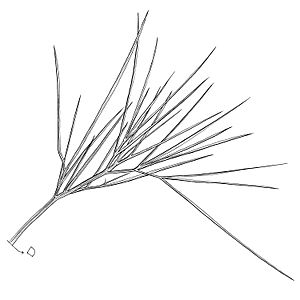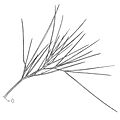Aciphylla aurea facts for kids
Quick facts for kids Aciphylla aurea |
|
|---|---|
 |
|
| Scientific classification | |
| Genus: |
Aciphylla
|
| Species: |
aurea
|
Aciphylla aurea, also known as golden speargrass or golden Spaniard, is a unique plant found only in the South Island of New Zealand. It gets its name "aurea" from its bright golden-yellow color. This plant can grow up to 100 centimeters (about 3 feet) tall. It has sharp, spiky, yellowish-green leaves. You'll usually find golden speargrass in mountainous areas, but it can also grow in dry, grassy places at lower heights. It lives at altitudes from 300 to 1,500 meters (about 1,000 to 5,000 feet) above sea level. Its flowers are yellow or cream-colored and bloom from January to February. The flower head is very spiky and quite large.
Contents
What is Golden Speargrass?
Golden speargrass is easy to spot because of its strong, bushy flower head. This head can grow up to 1.5 meters (about 5 feet) tall when the plant is flowering, usually from November to December. The flower head can stay on the plant for up to two years! The flowers themselves are a special yellow color and are shaped like stars. The leaves of the plant are clumped together and have a yellowish-green or golden color. They can grow up to 70 centimeters (about 2.3 feet) long. The plant produces fruit between January and February.
Where Does Golden Speargrass Live?
Its Home in New Zealand
Golden speargrass is a native plant of New Zealand. This means it naturally grows there and nowhere else in the world. It is mostly found along the east coast of the South Island, from Marlborough and Nelson down to northern Southland. It prefers low to medium mountain areas, usually between 300 and 1,500 meters above sea level. Other types of Aciphylla plants live all over New Zealand, each adapted to different environments.
What Kind of Places Does it Like?
Aciphylla aurea loves mountainous areas with soil that drains water well. This includes rocky spots and tussock grasslands (areas with clumps of grass). This plant is very tough and can handle extreme weather conditions. It can survive fires and very cold temperatures, even down to -17 degrees Celsius (about 1 degree Fahrenheit)! Because it's so tough, golden speargrass now grows widely in many alpine and tussock grasslands.
How Does Golden Speargrass Grow and Reproduce?
Flowering and Fruiting Times
Golden speargrass flowers in New Zealand during the early summer months, usually November and December. However, it doesn't flower a lot every year. It has a big flowering period only every few years. The plant produces fruit in the late summer months, from January to February. This means that animals help to pollinate its flowers.
How Seeds Spread
The seeds of golden speargrass are spread by the wind. This is called "aneomochory." The seeds are light and have a large surface area compared to their weight, which helps the wind carry them far away. This is common for plants that live in windy mountain areas. The seeds usually look dark brown and are about 5 to 7 millimeters long.
Who Eats Golden Speargrass?
Golden speargrass prefers dry, windy mountain soils. It likes drier climates compared to some of its plant relatives. Before humans brought new animals to New Zealand, the main animal that ate golden speargrass was the Moa, a large, now extinct bird.
Today, animals like sheep and other grazing animals eat the long, colorful leaves of the plant. They usually don't eat the tall flower stalks. Since sheep were introduced, golden speargrass has become more tolerant to being eaten by them. This is one reason why it is now so common in the high country tussock and grasslands.
Images for kids
See Also




